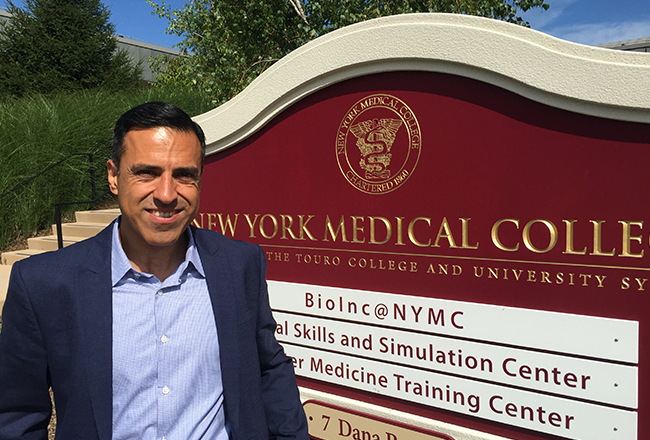
On Sept. 20, Jill E. Douglass, assistant professor in Sacred Heart University”™s Speech Language Pathology Program, will launch the first in a monthly series of National Stuttering Association support group meetings for children who stutter and their families.
These group meetings, which will take place on the third Thursday of each month at the university”™s Center for Healthcare Education at 4000 Park Ave. in Bridgeport, represent the first of their kind for the Fairfield County region.
“It will be free to the public,” Douglass said. “It”™s not any behavioral therapy. It”™s a space to meet other people who stutter, other families and parents of kids who stutter. It”™s a place to be social and a place to share and to stutter judgment-free. We are trying to develop an emotional support system ”” sharing resources that parents might not be aware of, sharing experiences that children are getting in schools or concepts that parents might need to advocate for in the school.”
Douglass observed that there is still too many misconceptions regarding the causes and treatment of stuttering. “A person who stutters is not stuttering because they”™re nervous or because of XYZ,” she said. “It is involuntary, it is a loss of control.”
So, what causes stuttering? Douglass said that there is no easy explanation.
“The best way we can describe it is a perfect storm of happenings,” she said. “There is a neurological element along with a genetic element ”” predisposition ”” along with a social, emotional motor. It”™s a perfect storm of all of these elements having this imbalance at the early years of life, when a child is just starting to boom with their language. At the age of three, and sometimes as young as two-and-a-half and then up till five, you might see it begin because the child”™s body and all of these elements are in this boom of development. And for this child, their fluency gives way and they start stuttering.”
While most children will be able to overcome their stuttering by the time they reach 6 or 7, Douglass added, others continue and their situation becomes chronic over time. Today, she noted, there are three main approaches to stuttering therapy: stuttering modification, where the impediment is modified to create as minimal an impact as possible; fluency shaping, which attempts to increase the individual”™s speech fluency; and a cognitive restructuring that works with the emotional cognitive impact at the root of the stuttering with the goal of encouraging change in the behavioral elements.
Douglass became involved with the National Stuttering Association during her graduate studies “so I could see a bigger picture.” When she first attended the organization”™s national conference, she had an epiphany on the subject.
“For the first time, I was a fluent speaker among a majority who stutter and I found that exceptionally humbling,” she recalled. “Stuttering therapy has been evolving over decades and there was a time when it was thought that we can get rid of stuttering. But that”™s not truly the case.”
There is also a question of public empathy to those who stutter. While three generations grew up laughing at the animated antics of stuttering Porky Pig ”” Douglass noted the character”™s original voice actor, Joe Dougherty, was a stutterer himself and lost the job because his stutter grew more severe over time ”” the 2010 Oscar-winning film “The King”™s Speech” raised mature awareness of the issue through its sympathetic central character in Britain”™s King George VI and his patient efforts to gain speech fluency. Still, Douglass recalled one example where bumbling Porky Pig was viewed as something of a hero.
“I know this one fellow, a researcher in the stuttering world who stutters and he wears a Porky Pig pin on his lapel,” she said. “Just because it was such a part of his childhood and he just had to turn it to the positive in that it shed light on stuttering. It shows us how relevant pop culture is with these different diagnoses ”” it sets the tone. Is it the butt of the joke, like Porky Pig, or is it inspirational like ”˜The King”™s Speech”™?”
In both her client work and in her upcoming group meetings, Douglass aims to educate parents that the best input they can provide to children who stutter is the ability to recognize what they can accomplish by being their true selves.
“One of my goals with parents is they develop what is called in the literature a parental locus of control, where they can come to appreciate that they can only control themselves,” she said. “Rather than the parent channel their feeling of helplessness into the child, the parent should be mindful of their own feelings and show the child they are comfortable in their own skin and are listening. That is far more beneficial for that child to experience.”























This is great news. This NSA/SHU chapter will be a valuable resource for people who stutter in CT/Westchester . I knew of a stuttering support group in Stamford circa 1998 but do not know what happened to it. Kudos to the speech department at SHU. I am happy that CT has great speech-language pathology education at both SHU and SCSU. Also, the website of the Stuttering Foundation (www.stutteringhelp.org) is well-known for giving out many free resources. I have downloaded complete books from the site. The Hispanic communities in Westchester and Bridgeport can benefit from the Spanish edition of the Stuttering Foundation website (www.tartamudez.org)
Great news! Looking to start a family chapter here in Philadelphia possibly, so this is really encouraging to read this. I’ve thought about hosting different activities that are not just therapy related like barbecues or bowling outings to encourage people who stutter to not feel confined to interacting through just therapy